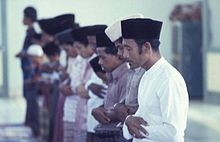Taqiyah (cap)
The Taqiyah (Arabic: طاقية, ALA-LC: ṭāqīyah[note 1]), also known as tagiyah or araqchin (Persian: عرقچین; Turkish: takke), is a short, rounded skullcap worn by Muslim men.
Aside from being an adornment, the taqiyah has deeply ingrained significance in Islamic culture, reflecting the wearer's faith, devotion, and sometimes regional identity.
While the taqiyah is deeply rooted in Muslim traditions, its use varies based on cultural context rather than strict religious guidelines.
In the Indian subcontinent, it is called a topi (Bengali: টুপি, Hindi: टोपी, Urdu: ٹوپی) which means hat or cap in general.
In Afghanistan men wear all sorts of araqchin, with different designs depending on the wearer's ethnicity, village and affiliations.
They wear their araqchins with a peran tomban or perahan wa tonban, which means 'shirt and trousers' in the Persian of Afghanistan, which corresponds to a different, more archaic version of the shalwar kameez, being collarless, and of a wider cut.
But due to war, the traditional peran tomban is less and less used, and the shalwar kameez with a collar is becoming more and more used, specially by Eastern Afghans, and people coming from poor backgrounds.
[citation needed] The prayer cap in Bangladesh is known as a ṭopi, from the Prakrit term ṭopiā, meaning 'helmet'.
In Russia, the tubeteika is worn with a suit for Eid ul Fitr or Jumu'ah, and a tuxedo for wedding ceremonies.
[citation needed] Men in Somalia often wear the koofiyad cotton prayer cap, along with a sarong referred to as a macawiis.
[citation needed] Before 1925, men used to wear the fez hat and calpack, or a conical taqiyah known as the taj.
The Turkish cap is made of wool or cotton fleece and has a distinctive pom-pom or toorie on top.
The tahýa is an indispensable item of the national male garment, often worn on daily basis, along with another traditional headgear, the telpek, a sheepskin hat.
[9] In ancient times, Turkmens believed that the tahýa protects the owner from the evil eye and other troubles.
In an effort to strengthen religious awareness for foreign visitors, Sheik Mohammed Bin Rashid Al Makthoum, the crown prince of Dubai, has, from 2012 onwards, requested that all visiting westerners and non-Muslims adhere to Islamic dress code during religious festivals.
Also, followers of the Naqshbandi Haqqani Sufi Order wear Uzbek Kufis as Bahauddin Naqshband was from Uzbekistan and it is seen as a friendlier alternative to the austere solid black and white of some Muslims.
[citation needed] Traditional Malaysian men's attire consists of a shirt, matching pants, and waist wrap that is called a baju Melayu.
[citation needed] In East Africa, the kofia is commonly worn in the Muslim communities in the coastal areas of Kenya, Tanzania, and Uganda.
[citation needed] In West Africa, there is the kufi hat, or alasho/tagelmust turban, which is worn with the grand boubou for all official functions, weddings, and Islamic celebrations.
Another West African robe is called a Senegalese kaftan which is similar to an Arabic thobe, but with a different tailored cut, and the kufi or fez is often worn with it.
As in Morocco, the gandora and djellaba is also worn by West African men, especially in domestic settings or for in-home prayers.








